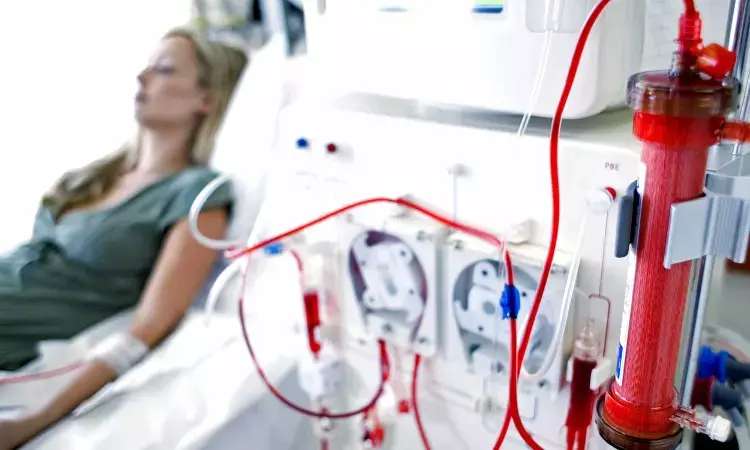- Home
- Medical news & Guidelines
- Anesthesiology
- Cardiology and CTVS
- Critical Care
- Dentistry
- Dermatology
- Diabetes and Endocrinology
- ENT
- Gastroenterology
- Medicine
- Nephrology
- Neurology
- Obstretics-Gynaecology
- Oncology
- Ophthalmology
- Orthopaedics
- Pediatrics-Neonatology
- Psychiatry
- Pulmonology
- Radiology
- Surgery
- Urology
- Laboratory Medicine
- Diet
- Nursing
- Paramedical
- Physiotherapy
- Health news
- Fact Check
- Bone Health Fact Check
- Brain Health Fact Check
- Cancer Related Fact Check
- Child Care Fact Check
- Dental and oral health fact check
- Diabetes and metabolic health fact check
- Diet and Nutrition Fact Check
- Eye and ENT Care Fact Check
- Fitness fact check
- Gut health fact check
- Heart health fact check
- Kidney health fact check
- Medical education fact check
- Men's health fact check
- Respiratory fact check
- Skin and hair care fact check
- Vaccine and Immunization fact check
- Women's health fact check
- AYUSH
- State News
- Andaman and Nicobar Islands
- Andhra Pradesh
- Arunachal Pradesh
- Assam
- Bihar
- Chandigarh
- Chattisgarh
- Dadra and Nagar Haveli
- Daman and Diu
- Delhi
- Goa
- Gujarat
- Haryana
- Himachal Pradesh
- Jammu & Kashmir
- Jharkhand
- Karnataka
- Kerala
- Ladakh
- Lakshadweep
- Madhya Pradesh
- Maharashtra
- Manipur
- Meghalaya
- Mizoram
- Nagaland
- Odisha
- Puducherry
- Punjab
- Rajasthan
- Sikkim
- Tamil Nadu
- Telangana
- Tripura
- Uttar Pradesh
- Uttrakhand
- West Bengal
- Medical Education
- Industry
Daprodustat an effective alternative treatment for anemia in incident dialysis patients: JAMA

Daprodustat is an effective alternative treatment for the treatment of anaemia of chronic kidney disease in incident dialysis patients, according to a recent study published in the JAMA Internal Medicine.
Daprodustat, a hypoxia-inducible factor prolyl hydroxylase inhibitor, is being evaluated as an oral alternative to conventional erythropoiesis-stimulating agent (ESA) therapy. Few studies of anemia treatment in an incident dialysis (ID) population have been reported.
A study was conducted to evaluate the efficacy and safety of daprodustat vs darbepoetin alfa in treating anemia of chronic kidney disease in ID patients.
This prospective, randomized, open-label clinical trial was conducted from May 11, 2017, through September 24, 2020, in 90 centres across 14 countries. Patients with advanced CKD were eligible if they planned to start dialysis within 6 weeks from screening or had started and received hemodialysis (HD) or peritoneal dialysis (PD) within 90 days before randomization, had screening hemoglobin (Hb) concentration of 8.0 to 10.5 g/dL (to convert to grams per litre, multiply by 10) and a randomization Hb of 8.0 to 11.0 g/dL, were ESA-naive or had received limited ESA treatment, and were iron-replete. The primary analysis in the intent-to-treat population evaluated the mean change in Hb concentration from baseline to evaluation period (weeks 28-52) to assess the noninferiority of daprodustat vs darbepoetin alfa (noninferiority margin, −0.75 g/dL). The mean monthly intravenous (IV) iron dose from baseline to week 52 was the principal secondary end point. Rates of treatment-emergent and serious adverse events (AEs) were also compared between treatment groups to assess safety and tolerability.
Results:
A total of 312 patients (median [IQR] age, 55 [45-65] years; 194 [62%] male) were randomized to either daprodustat (157 patients; median [IQR] age, 52.0 [45-63] years; 96 [61%] male) or darbepoetin alfa (155 patients; median [IQR] age, 56.0 [45-67] years; 98 [63%] male); 306 patients (98%) completed the trial. The mean (SD) Hb concentration during the evaluation period was 10.5 (1.0) g/dL for the daprodustat and 10.6 (0.9) g/dL for the darbepoetin alfa group, with an adjusted mean treatment difference of −0.10 g/dL (95% CI, −0.34 to 0.14 g/dL), indicating noninferiority. There was a reduction in mean monthly IV iron use from baseline to week 52 in both treatment groups; however, daprodustat was not superior compared with darbepoetin alfa in reducing monthly IV iron use (adjusted mean treatment difference, 19.4 mg [95% CI, –11.0 to 49.9 mg]). Adverse event rates were 76% for daprodustat vs 72% for darbepoetin alfa.
Thus, this randomized clinical trial found that daprodustat was noninferior to darbepoetin alfa in treating anemia of CKD and may represent a potential oral alternative to a conventional ESA in the ID population.
Reference:
Efficacy and Safety of Daprodustat for Treatment of Anemia of Chronic Kidney Disease in Incident Dialysis Patients: A Randomized Clinical Trial by Ajay K. Singh, et al. published in the JAMA Internal Medicine.
Dr. Shravani Dali has completed her BDS from Pravara institute of medical sciences, loni. Following which she extensively worked in the healthcare sector for 2+ years. She has been actively involved in writing blogs in field of health and wellness. Currently she is pursuing her Masters of public health-health administration from Tata institute of social sciences. She can be contacted at editorial@medicaldialogues.in.
Dr Kamal Kant Kohli-MBBS, DTCD- a chest specialist with more than 30 years of practice and a flair for writing clinical articles, Dr Kamal Kant Kohli joined Medical Dialogues as a Chief Editor of Medical News. Besides writing articles, as an editor, he proofreads and verifies all the medical content published on Medical Dialogues including those coming from journals, studies,medical conferences,guidelines etc. Email: drkohli@medicaldialogues.in. Contact no. 011-43720751


